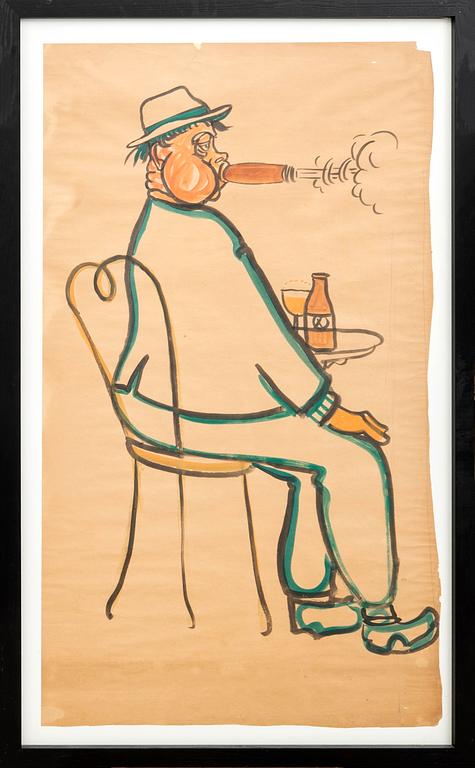Carl Kylberg
Carl Kylberg, watercolour not signed
142x82 cm
Not examined out of frame. Hole. Damages.
More information
In this previously unknown picture series, Carl Kylberg has been inspired by the art of dying. In an experimental modernist narrative without order, we find clowns with infernal laughs, families with tightly leashed dogs, pale aunts, red crosses and impressionistically grandiose depictions of paradise.
The first decade of the 20th century is important for Kylberg and his basic philosophy. During his time in Berlin, he decides to abandon architectural studies in favor of the artistic profession and makes his first pastels with biblical motifs. In Gothenburg during the first years of the 20th century, he was inspired by his close friend Ivar Arosenius. In 1906, he works with August Strindberg and performs scenography for Intima Teatern and, among other things, makes copies of Arnold Böcklin's paintings The Island of Life and Death.
This picture series was probably intended for a play. Possibly it was performed as a proposal for scenography for August Strindberg's short story "Taklagsöl". It was written in 1906, the same year Kylberg had Strindberg as a client. Strindberg planned to stage this play and engaged several of his collaborators. The story is about a conservator who is near death and in confused fever dreams looks back on his life.
In the set design by Kylberg we find a series of monologues with pranksters, saints and Nordic crusaders. The environment is generally restrained with maximum simplicity, intimacy and spare details. The outlines of the figures are made with a black outer marker line. The technique is seemingly simple and cultivated with a built-up and clear coloring. The works are painted with watercolor paint on paper from a roll of paper, a anything but grand choice of material.
In the motifs with Viking ships, the undulating and meditative appearance of the sea is present and symbolizes the importance of the journey. Ideas about human destiny as a journey, which one can assume will function as harmonious passages in a narrative, repetitions in life that can be repeated. In one of the works, we understand that the higher up the stairwell you are, the closer you are to heaven.
In the Matisse-inspired paradises, we get a glimpse of peace and harmony, a total idyll, perhaps a possible solution to an existential crisis. Something that, however, seems to work best in the bar with a bottle of absinthe. Kylberg portrays a person who, despite his halo, gets drunk. Perhaps a desire to convey that there is not necessarily a contradiction but rather a similarity between a socially maladjusted artist and a good Samaritan.
/ Frederick Anthony
Artist
Carl Kylberg, 1878-1952, is considered a seminal figure in the Swedish 1900-century art. He was a student at the architecture department at Berlin University and then a student of Carl Wilhelmson at Valand art school in Gothenburg.
Kylberg broke through late, made his debut as a painter in 1919 with the February group at Liljevalchs. He became known to a wider public by the age of 50, but continued to be controversial as an artist. He had a permanent artistic antagonist of Isaac Grünewald and the same year as the Nazis in Germany set up the decisive blow against Entartete Kunst and practically the whole of modernism, Swedish government stopped the purchase of the painting "Uppbrottet" of the National Museum in Stockholm.
Read more






























